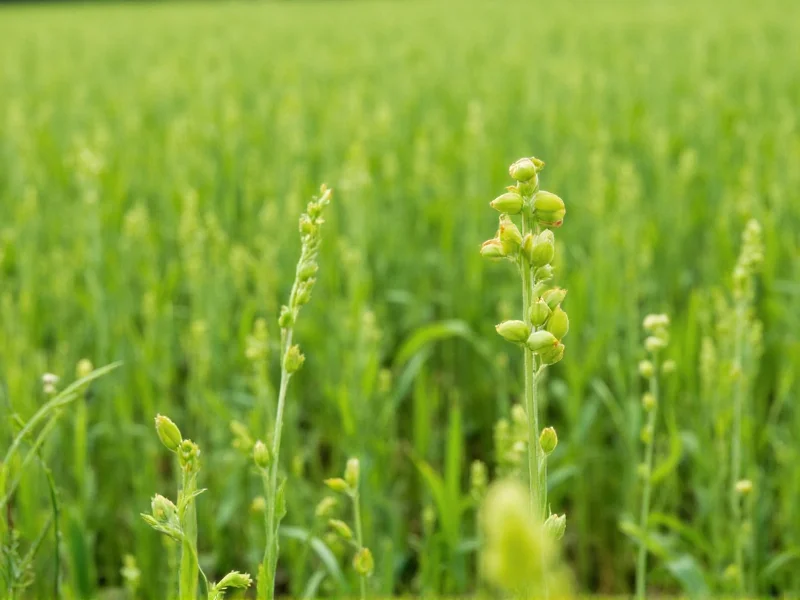Lentils represent one of the oldest cultivated crops, with archaeological evidence dating back 8,000-9,500 years to the Near East. These hardy legumes have sustained human populations through millennia due to their nutritional value and adaptability to diverse growing conditions. Understanding the lentil plant's characteristics and requirements helps gardeners and farmers maximize yields while improving soil health.
Botanical Characteristics of Lentil Plants
Lentil plants feature delicate, branching stems that typically reach 15-50 cm in height, though some varieties can grow taller under ideal conditions. The plants produce pinnate leaves with 4-7 pairs of oblong leaflets and terminate in a tendril instead of a flowering stem. Small white, pink, or blue flowers develop singly in leaf axils, eventually forming small pods containing 1-2 lens-shaped seeds.
The distinctive seed shape gives lentils their scientific name Lens culinaris. These seeds come in various colors including green, brown, red, yellow, and black, with some varieties featuring speckled or mottled patterns. Unlike many legumes, lentils don't have a hard seed coat, which contributes to their relatively quick cooking time compared to other dried beans.
Optimal Growing Conditions for Lentils
Successful lentil plant cultivation depends on several environmental factors. These cool-season crops perform best in temperatures between 18-24°C (64-75°F) during vegetative growth, with slightly warmer conditions (24-29°C or 75-84°F) preferred during flowering and pod development. Lentils cannot tolerate frost during flowering, making proper planting timing crucial.
| Growing Requirement | Optimal Range | Notes |
|---|---|---|
| Soil Type | Sandy loam to clay loam | Requires excellent drainage; heavy clay soils increase disease risk |
| Soil pH | 6.0-7.5 | Can tolerate slightly alkaline conditions but not acidic soils |
| Water Needs | 30-50 cm total | Most critical during flowering and pod fill; avoid waterlogging |
| Sunlight | Full sun | Minimum 6-8 hours daily for optimal growth |
| Growing Season | 80-110 days | Varies by variety and growing conditions |
Planting and Care Requirements for Lentil Plants
For successful lentil plant care, plant seeds 1-2 cm deep after the last spring frost when soil temperatures reach at least 10°C (50°F). Space seeds 2-5 cm apart in rows 20-30 cm apart. Lentils establish better when planted directly in their final location, as they don't transplant well due to sensitive root systems.
While lentils fix atmospheric nitrogen through root nodules, they benefit from phosphorus-rich soil amendments before planting. Avoid nitrogen fertilizers, which encourage excessive foliage growth at the expense of seed production. Water lentils consistently during flowering and pod development, but reduce irrigation as seeds mature to prevent mold and facilitate drying.
Lentil Plant Growth Stages
Understanding the lentil plant growth stages helps growers anticipate care needs and harvest timing:
- Germination (5-10 days): Seeds sprout with taproot development
- Vegetative growth (20-30 days): Stem elongation and leaf production
- Flowering (10-15 days): White, pink, or blue flowers appear
- Pod development (20-30 days): Seeds form and expand within pods
- Maturation (15-20 days): Plants yellow and dry as seeds harden
Most varieties complete this cycle in 80-110 days. The plants naturally senesce when seeds reach physiological maturity, turning yellow and drying out completely.
Common Lentil Varieties and Their Characteristics
Different lentil varieties offer varying lentil plant height and structure characteristics:
- Green lentils: Upright growth habit (30-50 cm), medium-sized seeds, earthy flavor
- Brown lentils: Semi-erect growth (25-40 cm), small seeds, mild flavor
- Red lentils: Shorter stature (20-35 cm), seed coat removed, cook quickly
- Black beluga lentils: Compact growth (20-30 cm), small shiny seeds resembling caviar
- Puy lentils: Medium height (30-45 cm), speckled blue-green seeds, French origin
Choosing the right variety depends on your climate, soil conditions, and culinary preferences. Some varieties perform better in specific regions due to their adaptation to local growing conditions.
Pest and Disease Management for Lentil Plants
Several challenges affect common pests affecting lentil plants. Aphids, cutworms, and weevils can damage foliage and seeds, while fungal diseases like ascochyta blight and botrytis gray mold threaten plants in humid conditions. Implement these strategies for healthy plants:
- Rotate lentils with non-legume crops every 3-4 years to reduce soil-borne diseases
- Use certified disease-free seeds to prevent introducing pathogens
- Provide adequate spacing for air circulation to minimize fungal issues
- Monitor plants regularly for early pest detection
- Apply organic insecticidal soaps for aphid control when needed
Lentils' natural resistance to many pests makes them relatively low-maintenance compared to other legumes, especially when grown in appropriate conditions.
Harvesting and Processing Lentil Plants
Timing your lentil plant harvesting time correctly ensures optimal seed quality. Harvest when 90% of pods have turned brown and seeds rattle inside dried pods. Morning harvesting when plants are slightly damp prevents excessive shattering. After cutting plants, allow them to dry further in a protected area for 1-2 weeks before threshing.
Threshing separates seeds from pods—this can be done by hand rubbing or using mechanical threshers for larger quantities. Winnowing removes chaff, leaving clean lentils ready for storage in airtight containers in cool, dark conditions where they maintain quality for 1-2 years.
Soil Health Benefits of Growing Lentils
One of the most valuable aspects of lentil plant nitrogen fixation benefits is their ability to improve soil fertility. Through symbiotic relationships with rhizobia bacteria, lentils convert atmospheric nitrogen into plant-available forms, adding 20-40 kg of nitrogen per hectare to the soil. This natural fertilization reduces the need for synthetic nitrogen inputs in subsequent crops.
As a rotation crop, lentils break pest and disease cycles affecting cereal crops while improving soil structure with their fibrous root systems. Their residue adds organic matter to the soil, enhancing water retention and microbial activity. These benefits make lentils an excellent choice for sustainable farming systems and home gardens practicing crop rotation.











 浙公网安备
33010002000092号
浙公网安备
33010002000092号 浙B2-20120091-4
浙B2-20120091-4